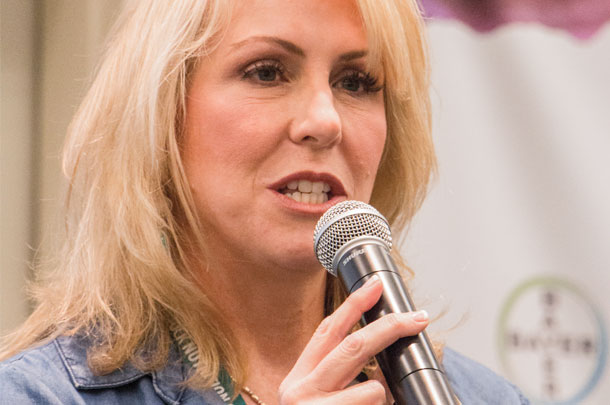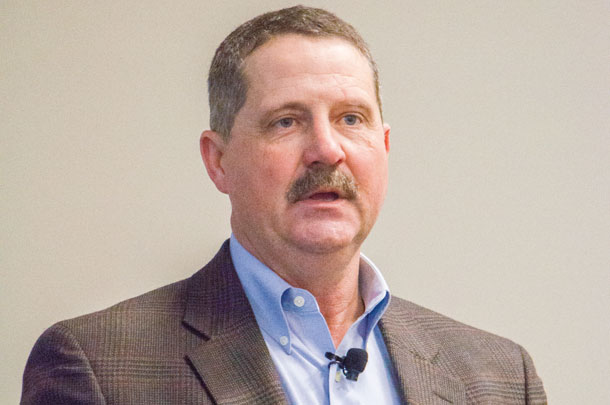To make a bull purchase a true investment, said seedstock producers Kelley Sullivan and Donnell Brown, you have to know the program selling you your sire. What they put into their bull development program is exactly what’s being placed into your own herd.
 Kelly Sullivan
Kelly Sullivan
Santa Rosa Ranch
Crockett, Texas
Sullivan, owner and operator of the Santa Rosa Ranch in Crockett, Texas; and Brown, owner of the R.A. Brown Ranch in Throckmorton, Texas, shared that insight and other points on a bull panel at the Texas Southwestern Cattle Raisers Association School for Successful Ranching in March.
“Understand whether the people you buy from are going to stand by what they do,” instructed Sullivan. “Where are they coming from? Are they doing what they say they’ll do?
“You’re investing in their program, and if you’re buying from a reputable program, they know they are investing in your success as well.”
 Donnell Brown
Donnell Brown
R.A. Brown Ranch
Throckmorton, Texas
A bull purchase can go beyond a few years and stretch beyond a decade, Brown said. “How long will a bull impact your herd? If you’re keeping replacement heifers, a bull you bought last year will impact your herd through 2034.
“I look at bull selection similar to selection for a spouse. I like to do more than just look at them. I want to know them, understand them and know their parents. Look at how much savvy (he) has.”
Commercial cattle producers rely on the seedstock industry. Just as the name implies, it sets a foundation genetically for how the herd will be determined for years to come. That requires the bull seller to accommodate a buyer with information.
DNA testing
Seedstock producers live by testing today, and Santa Rosa and R.A. Brown ranches are no different. Sullivan said breed associations now use genomic-enhanced expected progeny difference (EPD) indexes for the predictability of what you’re buying, and the buyer should expect their seller to have that data.
Sullivan said once a producer knows what its goals and priorities are for the herd, more questions will emerge to fit that objective. That’s when DNA and genomics become tools to fit the picture.
“We DNA everything we have. Unless we know what we have, we can’t sell it to you. It’s our responsibility as seedstock producers to give you as many tools as we possibly can.”
Brown said it may be more valuable for some to test females more than bulls. “I can learn more about genetic merit of that female by one DNA test than I can (through) a whole life of her productivity. It allows us to make more accurate genetic decisions to a significant degree.
“You shouldn’t buy a bull without genetic enhancement because it’s just more accuracy in making decisions. Just because a bull has EPDs doesn’t mean it’s good. The EPDs help what he is genetically.”
Brown added parental testing is also a valuable tool since some factors can cloud the certainty of parentage. A wrong semen straw can be pulled, or a wandering bull from two pastures over can service a cow, then roam back home without anyone knowing.
Balancing phenotypes
Sullivan said as much as buyers want to rely on data, there’s still value to observing cattle to make sure they meet the eye test.
“We can look at all these wonderful genetic elements, but if that bull can’t move and can’t walk, there’s no use to have him,” she said.
Buyers need to observe whether the bull is structurally sound, and conditioned and ready to work. Is the bull fleshy or is he stout? If a development ration has been given high on energy, he may be lacking body condition to do his job immediately.
If a buyer calls Santa Rosa Ranch asking for bulls without the chance to observe them, Sullivan says that’s where the seller has to go the extra mile.
“We’ve got to understand the programs we sell into. We tell them, ‘If they get off the truck, and not what you want, put them on the truck and send them right back.’”
Docility is also a factor that may have to be observed, especially if labor and facilities are factors in bull-buying.
“That is a huge selection criteria to us and a responsibility to our buyers,” Sullivan said. “They’re buying safety. A hot-headed bull is not going to do a lot for you.”
Sale criteria and price
When the sale comes, Brown said his marketing approach varies from others.
“I’m one of those guys who, for 44 years, hasn’t printed actual data,” he said. “We never printed a weaning weight, yearling weight or adjusted weight because I have tools that tell us so much more.”
Buyers can get those weights upon request, Brown explained. But his material markets Dollar Profit ($P) economic selection indexes comparing bulls’ impact on profitability over their productive life.
In addition to the standard selection materials – calving ease, growth, carcass, maternal and efficiency, Brown says the $P index show critical selection areas such as, “how well she breeds, how often she breeds, what size calf she raises, how well it marbles, how her daughters are going to mate, the fertility, the longevity – all those things that affect your profitability are in that index.”
Sullivan, on the other hand, says, “We’re different than most seedstock producers in that we have no production sale. Every bull we sell is off-ranch by private treaty. Every day is a sale day at Santa Rosa Ranch. That’s the way we’ve chosen to go about marketing our program.”
Both Sullivan and Brown agree on the old wisdom that a price range for a bull can be determined by the price of a healthy weaned calf times five.
“If you’re operating this business, you know how much you’re willing to pay for a bull. Some are a little less; some are a little more,” Sullivan said. “Some could be a potential sire herd prospect. But by and large, we’re consistent where our prices are concerned.
“Don’t go out and look for the cheapest bull out there; he’s probably not going to perform the way you want him to. So be willing to make the investment; that bull is half the genetics of that calf crop.” ![]()
PHOTO 1: Kelley Sullivan of Santa Rosa Ranch in Crockett, Texas.
PHOTO 2: Donnell Brown of R.A. Brown Ranch in Throckmorton, Texas. Photos by David Cooper.

-
David Cooper
- Managing Editor
- Progressive Cattleman
- Email David Cooper








